Green air of Rovaniemi seen to boost tourism
Published : 13 Aug 2017, 19:01
A 15-month exhaustive study from January 2016 to May this year bears it out that Rovaniemi, the capital of Finnish Lapland justly boasts of its pollution-free air.
The finding is seen to further boost the image of Rovaniemi as a green tourist destination.
“Rovaniemi and the entire Lapland will benefit from the study findings,” said Sanna Kärkkäinen, the managing director of Visit Rovaniemi which is tasked with developing the city’s tourism business.
In her words, “Finland has always been on top of the purest and cleanest countries nature-wise and Lapland is the cherry on top of the cake.”
The study measured the air qualities at two different points of the city and found it good, if not excellent.
One of the measurement points was the Ruokasenkatu Street to identify the air condition of a typical downtown area containing traffic emissions and dust, while the other point was chosen at the Suosiola power plant in Korkalovaara representing a typical small housing area.
“The study confirms the perceptions on Rovaniemi’s good air quality,” said Erkki Lehtoniemi, the head of Environmental Supervision at the City of Rovaniemi in a press release.
In Rovaniemi, air quality measurements had been carried out in the past, too, but not on the scale as this latest research.
Visit Rovaniemi plans to capitalise on the city’s air quality as it does on its temperature, said Sanna Kärkkäinen. “Definitely, we will utilise this information in marketing, especially in megacities like Shanghai and Beijing, for pure and clean air is a very important asset in tourism marketing.”
The study was conducted by Nab Labs Oy. The samples measured contained nitrogen oxides, respirable particles, fine particles and sulphur dioxide. For both 2016 and 2017, the fine particles were found to be below the limit set for annual average in both the points of measurement.
The air quality, however, temporarily weakened during the winter because of cold spells and in the spring due to street dust.


